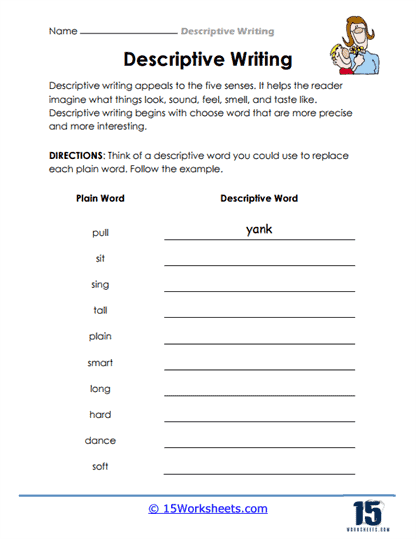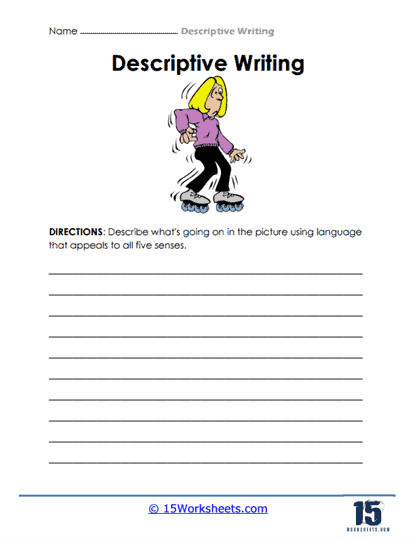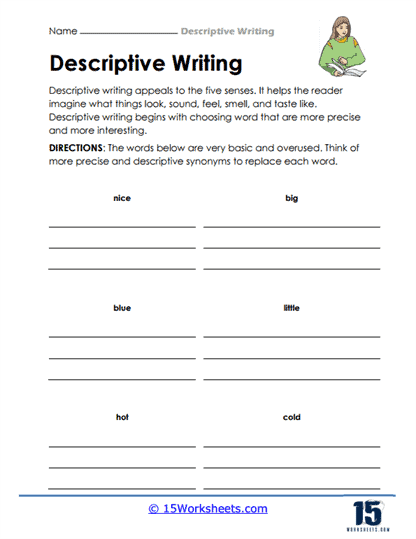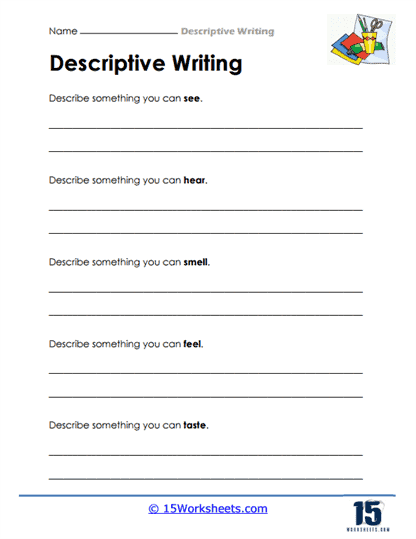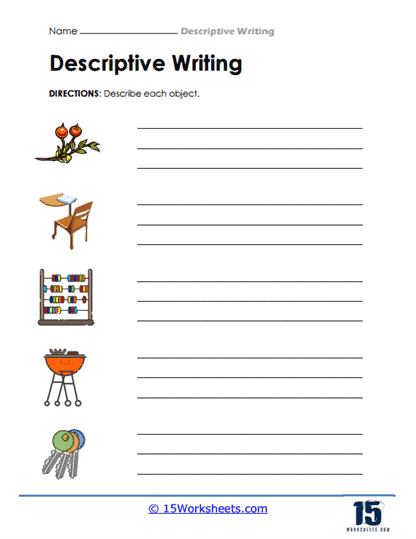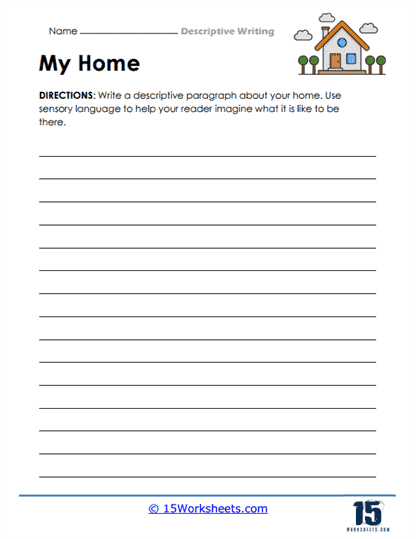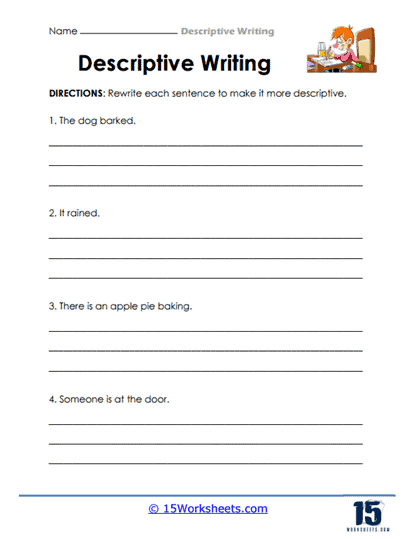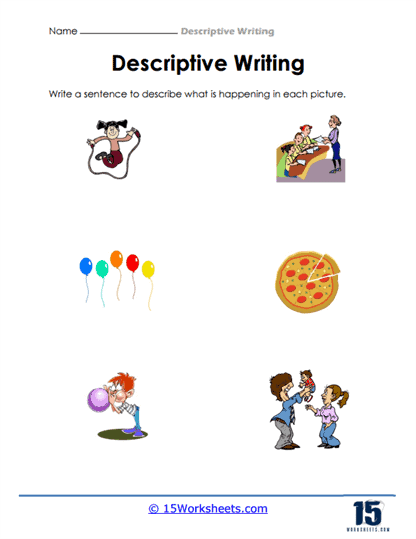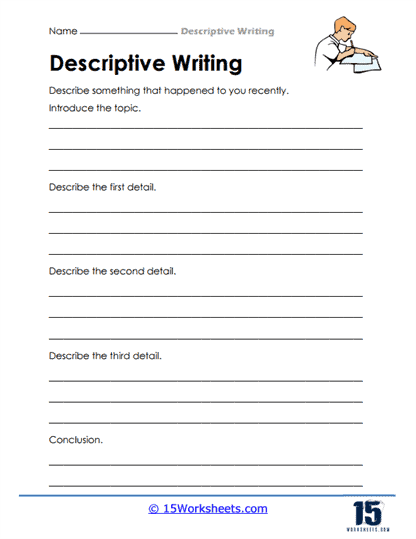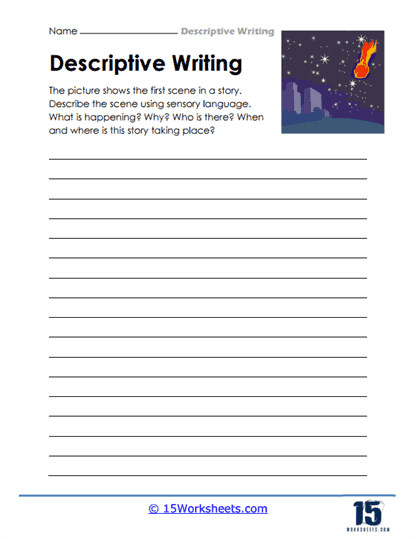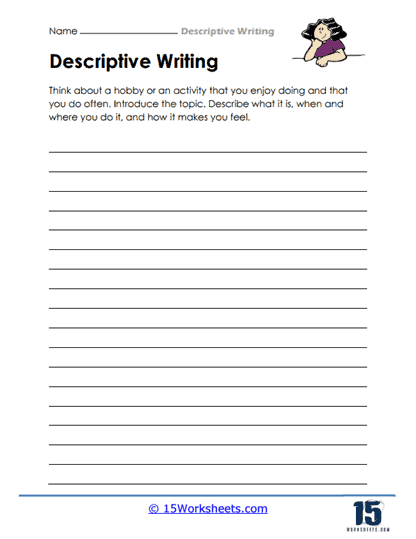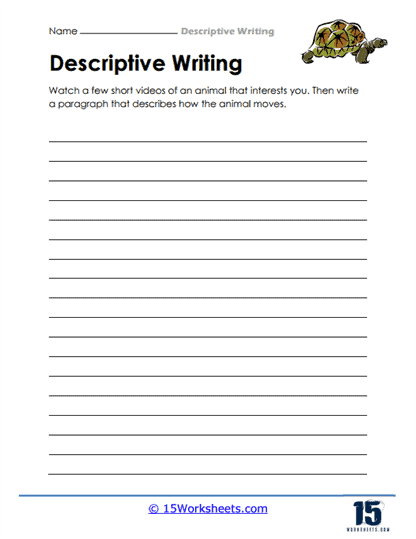Descriptive Writing Worksheets
All About These 15 Worksheets
Descriptive writing is a genre that relies on vivid language and sensory details to paint mental images and evoke emotions in the reader, and targeted worksheets help students strengthen these skills through a range of structured exercises. These worksheets often include activities such as brainstorming sensory details related to a topic to enhance imagery, analyzing figurative language like similes and metaphors to understand its impact, crafting descriptive paragraphs based on prompts or pictures, and editing weak or error-filled passages to improve clarity and engagement. Additionally, students may be tasked with writing full descriptive essays, giving them the opportunity to apply their skills in a more extended and organized format. Collectively, these activities support the development of rich, expressive, and effective descriptive writing.
A Look At Individual Worksheets
The adventure begins with foundational exercises like “Make It More” and “Replacing The Plain,” where students learn to enhance bland sentences by infusing them with descriptive flair. These activities challenge young writers to move beyond the mundane, encouraging them to replace overused phrases with more vivid and precise language. “Improving The Overused” further reinforces this skill by prompting students to identify and substitute clichéd expressions, fostering originality in their writing.
Sensory engagement is at the heart of descriptive writing, and worksheets like “The Five Senses,” “Describe Something,” and “Sounds Like” immerse students in exercises that hone their ability to depict experiences through sight, sound, taste, touch, and smell. By focusing on each sense individually, learners develop a nuanced understanding of how sensory details enrich narratives, making scenes more immersive and relatable.
To cultivate strong imagery, worksheets such as “Strong Imagery,” “Enriching Statements,” and “My Home” guide students in crafting vivid mental pictures for their readers. These activities emphasize the use of figurative language, metaphors, and similes, enabling writers to convey emotions and settings with depth and clarity. By describing familiar environments like their own homes, students practice translating real-life observations into compelling written descriptions.
Narrative development is further explored through prompts like “What Is Happening?,” “A Recent Happening,” and “The First Scene.” These worksheets encourage students to construct engaging storylines, focusing on the sequence of events and the buildup of tension. By analyzing and writing about specific incidents, learners enhance their ability to maintain coherence and interest throughout their narratives.
Personal reflection is nurtured in exercises such as “My Favorite Activity,” “An Interesting Animal,” and “A Familiar Location.” These prompts invite students to draw from their own experiences and interests, fostering a deeper connection between the writer and their subject matter. By articulating their thoughts and feelings about familiar topics, students develop a more authentic and expressive writing style.
What is Descriptive Writing?
Descriptive writing is a genre of writing that uses sensory details, vivid language, and imagery to create a mental picture or evoke emotions in the reader’s mind. It aims to paint a vivid and detailed picture of a person, place, object, or experience through words. Here are three detailed examples of descriptive writing:
Example #1
“The sun dipped below the horizon, casting a warm, golden glow across the tranquil beach. The gentle waves lapped against the powdery sand, leaving delicate patterns in their wake. The salty scent of the ocean mingled with the sweet fragrance of tropical blooms that adorned the shoreline. As I walked barefoot, the soft sand caressed my feet, and the cool water tickled my toes. Seagulls soared gracefully overhead, their cries echoing through the salty breeze. The scene was a perfect harmony of colors, sounds, and sensations, a serene oasis that enveloped me in its peaceful embrace.”
In this example, the descriptive writing transports the reader to a beach at sunset, utilizing sensory details to evoke a vivid image. The use of words like “warm,” “golden,” “tranquil,” “gentle,” and “soft” appeals to the reader’s senses, allowing them to visualize and experience the scene.
Example #2
“The towering oak tree stood majestically in the heart of the ancient forest. Its gnarled branches stretched out like skeletal fingers, reaching toward the sky. The leaves, a vibrant tapestry of crimson, amber, and gold, whispered in the breeze, creating a symphony of rustling sounds. Sunlight filtered through the dense canopy, casting dappled shadows on the moss-covered forest floor. The air was alive with the earthy scent of decaying leaves and the sweet aroma of wildflowers. As I stood beneath the mighty oak, a sense of awe and tranquility washed over me, as if I had entered a sacred realm of nature’s grandeur.”
In this example, the descriptive writing brings the reader into an ancient forest, capturing the essence of the environment through rich sensory details. The language paints a vivid picture of the tree’s appearance, the play of light and shadow, and the scents and sounds of the forest, creating an immersive experience for the reader.
Example #3
“Her eyes were like two sparkling sapphires, mesmerizing and full of depth. They held a universe of emotions, ranging from joy and laughter to quiet contemplation. Framed by long, silky lashes, they seemed to dance with every expression that crossed her face. Her smile, radiant and infectious, lit up the room, revealing perfectly aligned, pearl-white teeth. Each time she spoke, her voice was a melodic symphony, carrying a gentle warmth that enveloped those around her. She moved with grace and poise, every step exuding confidence and elegance. Her presence commanded attention, leaving an indelible impression on all who crossed her path.”
In this example, the descriptive writing focuses on capturing the physical and charismatic attributes of a person. The detailed descriptions of the eyes, smile, voice, and demeanor allow the reader to form a clear mental image and connect emotionally with the character being portrayed.
What Are the 3 Types of Descriptive Writing?
#1 Objective
Objective descriptive writing focuses on providing an unbiased and factual description of a person, place, object, or event. It aims to present an accurate portrayal without any personal opinions or judgments. Objective descriptive writing relies on concrete details, sensory observations, and precise language to paint a clear picture for the reader. This type of descriptive writing is commonly found in scientific reports, travel guides, and technical descriptions.
Example: “The Taj Mahal stands on the banks of the Yamuna River in Agra, India. Its grand white marble façade is adorned with intricate carvings and inlaid gemstones. The symmetrical architecture and minarets on each corner give the structure a sense of balance and elegance. The interior houses a breathtaking marble mausoleum with delicate floral motifs and an ornate cenotaph in the center.”
#2 Subjective
Subjective descriptive writing involves adding a personal touch and emotional response to the description. It goes beyond objective facts and incorporates the writer’s feelings, opinions, and interpretations. Subjective descriptive writing often uses sensory details, figurative language, and expressive vocabulary to evoke a specific mood or atmosphere. This type of descriptive writing is commonly found in creative writing, personal narratives, and literary descriptions.
Example: “The sun-kissed meadow spread before me, its lush green carpet swaying gently in the summer breeze. The fragrance of wildflowers filled the air, inviting me to explore their vibrant colors. As I walked through the field, the delicate petals brushed against my fingertips, and the grass tickled my bare legs. A sense of tranquility washed over me, as if I had stepped into a secret paradise, away from the worries of the world.”
#3 Comparative
Comparative descriptive writing involves drawing comparisons between two or more subjects, highlighting similarities, differences, or contrasts. It aims to provide a deeper understanding of the subject by presenting it in relation to something else. Comparative descriptive writing often uses similes, metaphors, and analogies to create vivid and imaginative comparisons. This type of descriptive writing is commonly found in literary analysis, persuasive essays, and critical reviews.
Example: “Her voice was as soothing as a gentle lullaby, calming my restless mind. The notes danced in the air, like butterflies fluttering their delicate wings. Each word she spoke was a brushstroke on a canvas, creating a masterpiece of emotion. In contrast, his voice pierced the silence like a sharp blade, commanding attention with its raw power. The words crashed against my ears like thunder, leaving a trail of intensity in their wake.”


